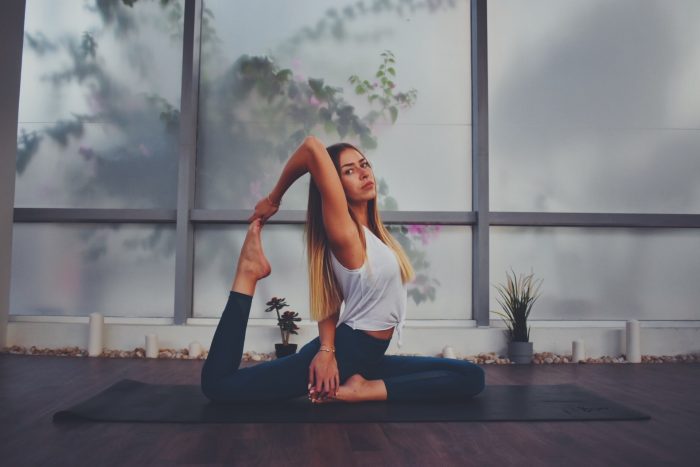The pandemic has caused us yoga instructors to take a mandatory break from touching students.
Those of us who are fortunate enough to still be teaching—whether online or in person—have had to refine our language, educate our eyes, and improve our demonstrations; in sum, to rely on tools other than touch to instruct.
After more than a year of hands-off instruction, and with no clear path to “normal” on the horizon, many of us have likely broken the habit of the routine physical adjustment. Now is a good time to take stock of what we have been doing with touch in our classrooms, and if/how/to what extent we want to bring it back.
Let me also say at the outset that I am neither pro- nor anti-touch. I am in favor of bringing the same conscious intelligence to relational touch that we endeavor to bring to the rest of our practices. These are my views based on my experiences in a United States context. I invite you to share your own in the comments, email, or in conversation.
The pandemic arrived in the middle of a broad cultural debate about consent, abuse of power, and—in our microcosm—the role of touch in the yoga classroom. How do students give or deny consent to be touched in a class setting? How do we ask students for consent without putting undue pressure (or to use Matthew Remski’s term, exerting somatic dominance) on them? This has caused fruitful community discussions as well as some convoluted policies: at one studio I’m familiar with, students sign a consent release, then don a consent bracelet, and finally verbally agree to be adjusted once per adjustment. As well-intentioned as these procedures may be, they are often cumbersome and can carry a strong whiff of legalistic ass-covering. And anyway, now they are on hold while we continue to protect each other and ourselves from COVID-19.
Before the pandemic, I was teaching several group classes and several private clients. I generally avoided adjusting anyone I didn’t know, but stopped trying to use my consent cards after baffling and irritating more than one group of seniors with them. In my group classes, I kept touch peripheral: repositioning hands and arms, steering a knee back on course, a two-finger down-and-out brush of the trapezius. Most of my private clients were enthusiastic adjustment recipients. The longer we worked together the more physical trust and rapport we developed, the more intimate adjustments we felt comfortable sharing. A few speak nostalgically to me now about hands-on adjustments. I try and teach them self-adjustment techniques. In one-on-one teaching, it’s simpler (though not always error-free) to maintain clear communication with students about if and when touch is welcome. It’s the public group class that includes relative strangers that we’re primarily concerned with here. My point here is that touch is best built on trust—that is, over time and in relationship.
Something that rankled me about many of the inventions for nonverbal consent communication was the focus on making it less and less attention-grabbing to say no. The consent card or poker chip with a yes and a no side was one iteration. Then the two sides of the poker chip were designed to look almost indistinguishable to prying eyes. This seems to say that your desire not to be touched is best kept secret. There is nothing wrong with privacy, but these solutions arose from a culture in which saying no was the exception, yes was the rule. The project has been: “how can we hear the quietest ‘no’?” instead of asking people to articulate their “yes” more clearly.
The secret-ization of the no-touch request also implies that not wanting touch is unusual, and is primarily about trauma. And while avoiding PTSD triggers is the most urgent reason not to do unwelcome touching, there are countless more mundane reasons that get minimized when we make consent a hush-hush business.
I’ve received lots of silly and/or incompetent adjustments I’d have happily skipped. One time in a full class, a popular teacher adjusted my supine twist (fine), and said “you’re the lucky one this evening” (not fine). If you’re touching students because you think your adjustments are god’s gift, perhaps it’s time to pause and take stock. I’ve also received adjustments that felt too intimate in that specific relationship: in plenty of classes over the years I’ve been feeling sweaty, and have felt self-conscious about being touched in that state by a relative stranger. A teacher who’s a friend is a different story; if they want to touch my sweaty shirt, that’s on them. And on some days, I simply want to be left alone to figure things out for myself.
I’ve also given adjustments, especially early on, that I know now were unnecessary and probably unwelcome. The fact that in 2010, when I began teaching, this conversation seemed too bizarre and difficult to have tells me that it was all the more urgently necessary. We were trained to give as many adjustments as possible on the assumption that everyone benefits from touch. The norms were heavy. Now we certainly know that’s not true. I know practitioners who still avoid public classes because they can’t tolerate the environment created by this assumption.
The yoga world is only a small (and often slightly behind the times) part of the ongoing cultural struggle around consent and sex. Ignoring the connections between intimate touches in asana class and sexual touch is exactly where our problems arise; we do so to our detriment. A wealth of evidence shows us that many people freeze and find it difficult to communicate “no” in the face of someone else’s desire to touch, whether it’s in the classroom or the bedroom.
One concept from the wider conversation that would serve yoga well is enthusiastic consent. If you want to have sex with someone but you don’t know if they want to have sex with you, it is not good practice to proceed trying to have sex with them unless or until they say “no.” Rather, you elicit enthusiastic consent, whether verbally (Yes!) or from an abundance of nonverbal cues. If you don’t know a person well enough to interpret their cues, or to talk frankly with them, the default must be: don’t proceed.
How might we bring the enthusiastic consent model into a yoga classroom (when we return to the classroom)? One vision goes like this:
At the beginning of class—let’s say there are 10 students—the teacher might say “I can give a maximum of three students hands-on adjustments today. If you’d like to be one of them, please raise your hand.” Three is an arbitrary number, but I think it should be less than half, and more than one, so it’s special but no one’s singled out. The teacher can keep track of volunteers mentally, or write names down so that if demand exceeds supply over time they can be sure to rotate fairly between students who wish to be adjusted. The teacher can also explicitly prioritize students who haven’t raised their hand before.
I like this scenario for several reasons. First, because itqa the norm from “everyone always gets adjusted unless they say they don’t want it” to “adjustments are specific, intentional, and you have to ask for them.” Anyone who doesn’t want to be adjusted for absolutely any reason can do nothing special, and not be touched. Second, because it slows a teacher down from robo-adjusting, and takes the pressure off to get to everybody, allowing them to focus and observe a couple specific bodies per lesson. Third, it makes adjustments more special, tuning both the teacher and student in to the physical thing that’s taking place between them, and giving the recipients a through-line of intentional touch, rather than the random occasional touch of a teacher flitting from one body to the next.
I also think it’s important for people who want to be touched to consciously, explicitly articulate that desire. If we find it difficult to say we want touch, this bears reflection. Many students have always come to yoga for the pleasure of social touch, whether that’s hugging classmates or being adjusted. This is fine and good. Especially after a year of lockdown I hope we’re empathetically aware of those who have had to be physically alone.
Some students learn better from touch than from listening or looking. Also fine and good. It’s useful to notice this about students, and to point this out to them, if they don’t know it already.
Students sometimes experience sexual or romantic transference toward their teachers, and may wish to be touched for these emotional reasons. This is normal, and we teachers must seek training to navigate these situations, to the degree that we’re able to perceive them. We may not always know when this is happening, but occasionally it is clear, and we would do well to discuss these situations with mentors, and in cases where it’s disruptive to class or disturbing to us, with the student directly.
In each of these cases, being asked (at the beginning of class, in an opt-in, rather than opt-out way) to state if you’d like to be touched will be a clarifying exercise for student and teacher.
One final situation that doesn’t get enough consideration is that of the teacher who doesn’t wish to touch. There is no such thing as one-way consent. Some teachers have never physically adjusted students, or have stopped after a specific traumatic incident or injury. A teacher may be ill or injured or tired, or may have any other season not to want to touch students.
No one is owed an adjustment.
The more explicitly we seek and grant or deny enthusiastic consent, the less murky, unconscious stuff is transmitted through touch. The less harm we do. And when we decide how and when we wish to touch, instead of feeling obliged at all times, we’re less likely to overextend or harm ourselves. Then touch can take its place in the toolkit alongside verbal adjustments, demonstrations, prop-work, and simple presence.
During the pandemic, I hope we’ve all experienced that touch is not better or worse than the many other skills and tools we possess, and it’s not essential to good teaching. Only when it’s welcome and freely given is it a gift to student and teacher.


 Share on bsky
Share on bsky





Read 5 comments and reply